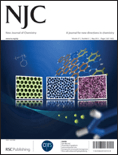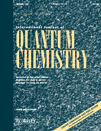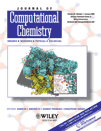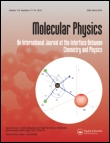
Computational and Theoretical Chemistry
Scope & Guideline
Catalyzing Collaboration in Chemistry and Physics
Introduction
Aims and Scopes
- Computational Chemistry Methods:
The journal emphasizes methodologies such as Density Functional Theory (DFT), ab initio calculations, and molecular dynamics simulations to investigate the electronic, structural, and thermodynamic properties of molecules and materials. - Material Science Applications:
Research often focuses on the design, optimization, and characterization of novel materials, including nanomaterials and two-dimensional materials, for applications in electronics, photonics, and energy storage. - Drug Design and Interaction Studies:
A significant portion of publications explores the computational aspects of drug design, including molecular docking, binding energy calculations, and the interaction of pharmaceuticals with various nanostructures. - Environmental Chemistry:
The journal includes studies on the adsorption and degradation of pollutants, offering insights into the environmental impact of chemical substances and potential mitigation strategies. - Theoretical Modeling of Reaction Mechanisms:
Research articles frequently delve into the mechanistic pathways of chemical reactions, utilizing computational methods to predict reaction rates, selectivity, and product formation.
Trending and Emerging
- Machine Learning Applications:
The integration of machine learning techniques in computational chemistry is on the rise, facilitating the prediction of molecular properties and reaction outcomes, thus enhancing the efficiency of research. - Nanotechnology and Drug Delivery Systems:
There is an increasing focus on the design and optimization of nanomaterials for drug delivery applications, highlighting the intersection of computational chemistry with pharmacology and materials science. - Sustainable Chemistry:
Research addressing environmental sustainability, including the development of green solvents and materials, as well as the study of pollutant degradation, is gaining prominence within the journal's scope. - Interfacial Studies:
Emerging studies on the interactions at interfaces, particularly in nanostructured materials and their applications in sensors and catalysts, are becoming more prevalent. - Complex Reaction Mechanisms:
There is a growing emphasis on unraveling complex reaction mechanisms, particularly in catalysis and biochemical processes, using advanced computational techniques to provide deeper insights.
Declining or Waning
- Classical Force Field Simulations:
While molecular dynamics simulations remain popular, the reliance on classical force fields has decreased as researchers increasingly adopt more sophisticated quantum mechanical approaches like DFT for greater accuracy. - Traditional Organic Synthesis Studies:
There has been a noticeable decline in publications focusing solely on traditional organic synthesis methods without computational backing, as the field shifts towards more integrated computational-experimental studies. - Basic Quantum Chemistry:
Papers focusing solely on fundamental quantum chemistry without practical applications or advanced computational techniques have become less common, indicating a move towards application-driven research. - Static Modeling Approaches:
The use of static models for predicting molecular behavior has waned in favor of dynamic simulations that account for molecular flexibility and environmental interactions. - Single-Parameter Studies:
Research that examines single parameters in isolation, without considering multi-faceted interactions or broader systems, is being supplanted by more holistic approaches that integrate various factors.
Similar Journals

CHEMICAL PHYSICS LETTERS
Your Gateway to Cutting-Edge Research in Physics and ChemistryCHEMICAL PHYSICS LETTERS, published by Elsevier, is a prestigious journal that has been at the forefront of advancing knowledge in the fields of physical and theoretical chemistry and physics since its inception in 1967. With an impressive impact factor reflective of its high-quality research output, this journal holds Q2 quartile rankings in both the Physical and Theoretical Chemistry and Physics and Astronomy categories for 2023. It is recognized as a key platform for disseminating groundbreaking findings, with Scopus rankings placing it within the top 76th and 66th percentiles in its respective categories. Researchers and professionals benefit from its insightful contributions and rigorous peer-review process, making it an essential resource for those engaged in cutting-edge chemical physics studies. Although the journal is not open access, it remains accessible through various institutional subscriptions, ensuring that a wide audience can explore its wealth of knowledge. Located in Amsterdam, Netherlands, the journal continues to drive innovation and collaboration across diverse scientific disciplines.

THEORETICAL CHEMISTRY ACCOUNTS
Exploring Innovative Pathways in Computational ChemistryTHEORETICAL CHEMISTRY ACCOUNTS is a prestigious journal dedicated to promoting the advancement of theoretical and computational chemistry. Published by Springer, this journal has become a vital resource for researchers, professionals, and students seeking to explore innovative theoretical approaches in chemistry since its inception in 1996. With a current impact factor positioning it in the Q3 category of Physical and Theoretical Chemistry, it underscores its importance in the academic landscape, ranking 113 out of 189 in its field according to Scopus. The journal embraces an Open Access model, making cutting-edge research widely accessible to the global community. Researchers are encouraged to submit their latest findings and theoretical advancements, contributing to the ever-expanding body of knowledge within this dynamic field. Addressing contemporary challenges and breakthroughs, THEORETICAL CHEMISTRY ACCOUNTS serves as an essential platform for dialogue and discovery among scholars dedicated to the intersection of chemistry and theory.

NEW JOURNAL OF CHEMISTRY
Pioneering Insights in Chemistry and CatalysisNEW JOURNAL OF CHEMISTRY, published by the prestigious Royal Society of Chemistry, serves as a vital platform for the dissemination of research in the dynamic fields of chemistry, catalysis, and materials science. With an impressive ISSN of 1144-0546, this journal boasts a rich history, having been established in 1996, and is set to continue its impactful publication through 2024. The journal is recognized in several categories, achieving a Q2 ranking in both chemistry and materials chemistry, and a Q3 rank in catalysis, reflecting its significance within these disciplines. Researchers will find it particularly noteworthy that the journal holds an esteemed position in the Scopus rankings, with a 65th percentile standing in general chemistry. Though it currently operates on a subscription model, its commitment to advancing the frontiers of chemistry makes it an essential resource for academics, professionals, and students seeking to keep abreast of the latest advancements and innovative methodologies in their fields.

INTERNATIONAL JOURNAL OF QUANTUM CHEMISTRY
Connecting Quantum Principles with Chemical InnovationInternational Journal of Quantum Chemistry is a distinguished scholarly publication that has been at the forefront of advancements in the realm of quantum chemistry since its inception in 1967. Published by Wiley in the United States, this journal holds a significant place in the academic community, currently indexed in the Q3 quartile across various categories including Atomic and Molecular Physics, Condensed Matter Physics, and Physical and Theoretical Chemistry. With an ISSN of 0020-7608 and an E-ISSN of 1097-461X, the journal offers a platform for researchers and professionals to disseminate cutting-edge findings in quantum chemical research. While it operates under a traditional subscription model, the journal remains committed to enhancing the visibility of its contributions within the scientific community. With a convergence of research that spans from 1967 to 2024, the International Journal of Quantum Chemistry is pivotal for anyone looking to advance their understanding and application of quantum principles in chemistry, providing valuable insights into the microscopic interactions that govern matter and its properties.

ACTA CHIMICA SINICA
Unveiling the Future of Chemistry through Rigorous ResearchACTA CHIMICA SINICA, published by SCIENCE PRESS, is a distinguished peer-reviewed journal in the realm of Chemistry, specifically focusing on general and miscellaneous chemistry fields. Since its inception in 1982, the journal has consistently contributed to the advancement of chemical research in China and beyond, maintaining a reputable standing within the academic community, evidenced by its 2023 Scopus ranking of #197 out of 408 in its category. With a current impact factor placing it in the Q3 quartile, ACTA CHIMICA SINICA aims to disseminate innovative research findings, covering a wide spectrum of topics within the discipline. Although it is not an open-access journal, it offers various access options through institutional subscriptions, ensuring that its high-quality content is available to a broad audience. Researchers, professionals, and students alike will find this journal a vital resource for keeping abreast of developments in the field and for contributing their own findings to an engaged scientific community.

PROGRESS IN REACTION KINETICS AND MECHANISM
Advancing the Frontiers of Reaction KineticsProgress in Reaction Kinetics and Mechanism is a distinguished academic journal published by SAGE Publications Ltd, focusing on the intricate dynamics of reaction kinetics and mechanisms within the field of Physical and Theoretical Chemistry. With an ISSN of 1468-6783 and an E-ISSN of 1471-406X, this journal serves as a critical platform for researchers and practitioners seeking to explore and disseminate cutting-edge findings from 1999 to 2024. Although currently not categorized as Open Access, the journal maintains a competitive profile with a Q4 categorization in its field, showcasing its commitment to fostering scientific dialogue and inquiry. The journal ranks #140 out of 189 in its category, reflecting its integral role in advancing knowledge and understanding in chemistry. Scholars, professionals, and students who aim to stay at the forefront of research in reaction kinetics will find valuable insights and findings in this esteemed publication.

INTERNATIONAL JOURNAL OF CHEMICAL KINETICS
Charting the course of kinetic research across disciplines.The INTERNATIONAL JOURNAL OF CHEMICAL KINETICS, published by Wiley, is a leading journal that covers significant advancements and fundamental research in the field of chemical kinetics. Established in 1969, this peer-reviewed journal not only emphasizes kinetics in solution and gas-phase reactions but also addresses theoretical approaches and experimental applications in various branches of chemistry including biochemistry, inorganic chemistry, organic chemistry, and physical chemistry. As of 2023, it holds a respectable Q2 ranking in Inorganic Chemistry and Q3 in the other chemistry categories, reflecting its substantial impact on the scientific community. With a commitment to disseminating high-quality research, the journal is an indispensable resource for researchers, educators, and students seeking to deepen their understanding of chemical dynamics. Its compilation of articles and reviews ensures that it remains a cornerstone for innovative studies and discussions within the field.

JOURNAL OF COMPUTATIONAL CHEMISTRY
Driving Discovery Through Computational ExcellenceThe Journal of Computational Chemistry, published by Wiley, is a premier platform in the fields of computational chemistry and computational mathematics. Established in 1980 and continuing through 2024, this journal serves as an essential resource for researchers, professionals, and students seeking to advance their understanding and application of computational methods in chemical research. With a commendable impact factor and ranking in the top quartile (Q2) for both Chemistry and Computational Mathematics, it boasts impressive Scopus rankings—22nd out of 189 in Computational Mathematics and 102nd out of 408 in General Chemistry, indicating its strong influence within these scientific communities. While it does not offer open access, the Journal of Computational Chemistry remains a vital venue for disseminating groundbreaking research and fostering collaboration in the computational science landscape. For those at the forefront of innovation, staying abreast of the latest findings published here is indispensable for advancing their work in theoretical and applied chemistry.

JOURNAL OF MOLECULAR MODELING
Connecting Researchers in the World of Molecular ScienceJOURNAL OF MOLECULAR MODELING, published by Springer, is a pivotal resource for researchers and professionals in the fields of chemistry, computer science, and molecular sciences. The journal's ISSN is 1610-2940, with an E-ISSN of 0948-5023, reflecting its commitment to disseminating cutting-edge research from 1996 to 2024. Although the journal does not operate under an Open Access model, it remains an invaluable platform for the publication of innovative studies related to computational methods, theoretical chemistry, and molecular simulations. With a notable categorization across multiple quartiles—including Q4 in Catalysis and Q3 in Computational Theory and Mathematics—the journal holds a distinct rank in Scopus, highlighting its influence and contribution to the discipline. The importance of this journal lies in its ability to bridge the gap between theoretical understanding and practical applications, making it essential reading for students and scholars seeking to advance their knowledge and research in molecular modeling.

MOLECULAR PHYSICS
Connecting theory and application in molecular physics.MOLECULAR PHYSICS, published by Taylor & Francis Ltd, is a distinguished international journal that has been advancing the fields of biophysics, condensed matter physics, molecular biology, and physical and theoretical chemistry since its inception in 1958. With an ISSN of 0026-8976 and an E-ISSN of 1362-3028, the journal provides a rich platform for the dissemination of high-quality research, evidenced by its Q3 ranking in several domains including both biophysics and condensed matter physics as of 2023. Although the journal operates on a traditional subscription model rather than an Open Access basis, its rigorous selection process ensures the publication of relevant and impactful articles. The journal's continued convergence of research until 2024 underlines its ongoing significance and adaptability in an ever-evolving scientific landscape. For researchers, professionals, and students alike, MOLECULAR PHYSICS serves as an essential resource for keeping abreast of the latest developments, fostering collaboration, and inspiring future advancements in molecular theory and applications.